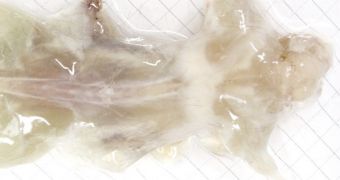While looking to better their knowledge of how the mammalian body works, researchers with the California Institute of Technology in Pasadena, US, managed to give everybody the creeps by creating completely see-through mice.
One such rodent is pictured in the photo next to this article, and it really is not all that difficult to tell that it is utterly and completely freaky. Not to mention the fact that it looks less like an animal and more like a mass of goo.
Writing in the journal Cell, the California Institute of Technology scientists behind this research project explain that their goal in developing transparent mice was to gain a better understanding of connections in the body.
It is believed that, with the help of see-through bodies like the ones of these mice, the scientific community could better pin down interactions between cells in the body. This would in turn pave the way to improved means of diagnosis and treatment options.
According to EurekAlert, the researchers who helped make the laboratory rodents see-through started by placing the animals in a special water-based gel intended to keep cellular structures and connections in their bodies intact.
The mice were then exposed to special detergents that removed all the fatty molecules present in their bodies. Since these fatty molecules were the reason the bodies were opaque at the beginning of this series of experiments, their removal caused the animals to become transparent.
As explained in the journal Cell, these experiments mark the first time scientists have ever managed to make organs transparent without having to remove them from an animal's body before toying with their makeup and, consequently, their opacity.
“Although the idea of tissue clearing has been around for a century, to our knowledge, this is the first study to perform whole-body clearing, as opposed to first extracting and then clearing organs outside the adult body,” study senior author Viviana Gradinaru said in a statement.
Furthermore, “Our methodology has the potential to accelerate any scientific endeavor that would benefit from whole-organism mapping, including the study of how peripheral nerves and organs can profoundly affect cognition and mental processing, and vice versa.”
This technique of turning organs transparent with the help of a water-based gel and detergents that wash away fatty molecules is dubbed CLARITY. Just last year, specialist Karl Deisseroth and fellow researchers at the Stanford University in California used it to make mouse brains transparent and thus gained access to the neural networks inside the organs without having to cut them up.

 14 DAY TRIAL //
14 DAY TRIAL //